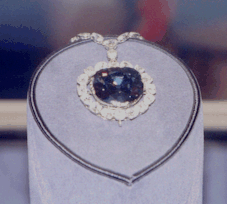

THE
CURSE OF THE IDOL'S EYE
The
history of the Hope diamond is uncertain, but it is thought to have begun in
1642 with a daring theft. Since then, an unfortunate crimes and disaster seem to have
followed the diamond. The
sapphire-blue gem is thought to have been cut from a much larger stone of more
than 112 carats (roughly the size of a Ping-Pong ball).
At one time the diamond served as the eye of an Indian idol.
It was taken by a Hindu priest and sold to a French adventurer named Jean
Baptiste Tavernier, who eventually sold it to King Louis XIV of France.
Later, both the priest and Tavernier met terrible fates.
It is said that Tavernier was been torn apart by wild dogs.
To improve the
diamond's brilliance, the king had the fabulous diamond recut to a 67-carat gem.
The stone, which came to be known as the French Blue, seemed to bring
disaster to anyone who touched it. One
government official who borrowed it was soon convicted of a crime and died in
prison. Louis XIV himself ended his days in disgrace.
The necklace was eventually passed on to Louis XVI and his wife, Marie
Antoinette, who occasionally wore it around her neck.
During the French Revolution, Marie Antoinette's neck was separated from
its head by the sharp blade of a guillotine.
A close friend of the queen, wore the jewel often.
She was beaten to death by an angry mob, also during the French
Revolution.
The French Blue
disappeared for a number of years. It
reappeared in London as a smaller gem of 44.5 carats.
Rumors spread that the British sea captain responsible for carrying it
across the English Channel committed suicide.
The jeweler thought to have cut the stone suffered a heart attack shortly
afterward.
British banker
Thomas Hope (thus the name which became associated with the diamond)
laughed at the stories and purchased the jewel.
His family fortunes declined rapidly, and the stone was sold to raise
cash. Over the next 16 years,
several owners of the Hope diamond were brought to ruin or even death, and
crimes associated with the stone increased.
In 1908, a Turkish sultan gave the diamond as a gift to his lady love.
A year later, he stabbed her to death and lost his throne. A Russian prince gave the necklace to an actress, also as a
symbol of his love. The following
year he shot her during a stage performance.
The next victim was killed in a carriage accident, along with his wife
and child.
Edward McLean,
then owner of the Washington Post newspaper, purchased the Hope in 1911.
The McLean family suffered many tragedies:
One son died in a car crash, a daughter died of a drug overdose, and
McLean himself died in an insane asylum. Nevertheless,
Mrs. McLean did not believe in the legendary curse. The diamond remained in the family until her death in 1947.
Harry Winston, an American diamond merchant, then acquired the Hope
diamond and presented it to the Smithsonian Institution in Washington, D.C.,
making it the property of the American people.
Which means you as an American citizen now own part of the diamond.
Is the curse of
the Hope diamond just an imaginative story?
Let's hope so.